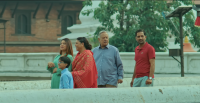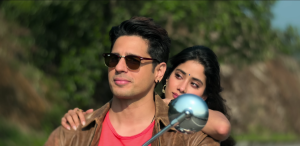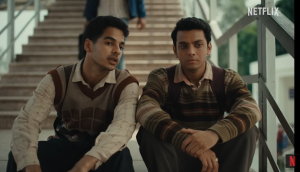Movies
Watch ‘Radha’ for Shristi Shrestha’s performance
A few days after its release, the production team of ‘The secrets of Radha’ pulled the film from theatres and said it would soon be launched on an OTT platform.
Abhimanyu Dixit
The review contains spoilers of the film.
As I write this review, ‘The Secrets of Radha’, Subarna Thapa’s latest film, is no longer playing in cinema halls. The film’s production team withdrew the film from theatres across the country, citing a lack of show slots.
Director Thapa, producer Devaki Bista, investor Saugat Malla, and actor Shristi Shrestha confirmed the withdrawal in a recent press conference. A visibly irritated Thapa claimed that the film released on September 26 to around 40 shows, a low number. But, by August 29, the number of shows had already gotten lower, even when reviews and audience feedback of the movie were overtly positive. “We now have 15 shows all over Nepal. This is a multiplex-targeted film, and theatre chains like QFX cinemas have only given us only three shows,” Thapa, also the film’s writer, said at the press conference.
Now, it looks like the film will be released on an OTT platform, and you will have to make do with watching it on your smartphone.
I watched the film in a cinema hall, and it is one of the most visually striking Nepali films released this year. A smartphone screen will not do justice to Narendra Mainali’s cinematography or Kala Sangraula’s art direction. Their work immerses you into the story and makes the film’s world believable. For example, the titular character, Radha, is often filmed in crowded spaces. But because of Mainali’s framing and Sangraula’s art, you can spot Radha from far away, never losing focus. Special mention ought to be given to the team for creating the set of a burnt village house, an absolute treat of a scene. The film’s audience would have also been able to experience the film’s full-fledged international quality audio with the background score by Christophe Héral, and sound designed/mixed by Frédéric Maury.
The film’s screenplay requires you to pay close attention in the first half. So, maybe the pause and rewind button of your OTT platform can assist you in the task. The screenplay jarringly jumps the timeline without any warning.
The film begins with Radha living with her ill mother-in-law (Sharada Giri). Basudev (Saugat Malla), Radha’s husband, has been missing for a few months. To calm her mother-in-law’s anxieties, Radha hires a caricature artist, Sundar (Khagendra Lamichhane), to talk to them in Basudev’s voice.
After her mother-in-law dies, Radha receives a letter claiming that Basudev has been found. Radha teams up with Sundar and travels to Kathmandu to find Basudev. In Kathmandu, Radha learns that Basudev has died, but when she goes to receive his coffin, the dead body is not of her husband.
The secret of what happened with Basudev and how Radha uncovers the truth is the crux of the film’s plot.
The film feels like a modern-day retelling of the Satyavan-Savitri story from Hindu mythology. In that story, Savitri, a devoted wife, through sheer willpower and devotion, saves her husband from the god of death, Yamaraj. Radha, the character, is also cut from the same cloth. Radha is a few months pregnant, yet she is determined to leave the comfort of her home to venture into the unknown. Before the end credit appears, Thapa dedicates the film to ‘the resilient spirit of women’. This is Thapa’s second woman-centric film—the first being Sungava (2012).
Now, whenever Thapa makes women-centric films, he does something very peculiar. Both ‘Sungava’ and ‘Radha’ end with the lead characters becoming mothers, and they are shown alongside a child. In ‘Sungava’, a story about two lesbians, Thapa kills one (Nisha Adhikari) and spares the other (Deeya Maskey) because she is now a mother. In ‘Radha’, Thapa begins with Radha’s pregnancy and ends with an image of Radha with her child. By ending the two films in such a way, it’s almost as though Thapa is suggesting that a woman’s ultimate goal is to become a mother.
When Nepali men write women-centric films, they tend to overcompensate. While writing women-centric stories, male writers put women characters on an extremely high pedestal, almost mythologising them. They tend to turn women into great human beings just because they can give birth and glorify raising children as sacrifices worth taking. Narratives such as these constantly reinforce the notion of women as mothers and hurt women.
The film’s screenplay, also written by Thapa, tries to negate glorification by attempting to humanise Radha. Thapa introduces us to a patriarchal world where Radha is constantly asked where her husband is. Radha lies and makes up stories to shut people out. In the opening scene, when a Mata (Sangeeta Urao) tells Radha that her fate is unclear, she scratches her palm to draw up her own fate, telling us how arrogant this person is. Radha longs for love, she cries, she shouts, and seeks help, just like a real person. As real as she is written, all would have been for nought had Thapa not found the perfect actor to play Radha.
One of actor Shristi Shrestha’s smartest career moves has been to collaborate with director Thapa for this film. Shrestha is perfectly cast. She is so good in the movie that we couldn’t have imagined anyone else playing the role.
To say Shrestha’s previous films have been rather disappointing would be an understatement. Before ‘Radha’, watching Shrestha act was a struggle. First, she disappointed you with her choice of film projects. She has been a part of some terrible projects like ‘Poi Paryo Kale’ (2019), a film that had no qualms with blackfacing actors. Her cameo role in ‘Mah’ (2022) was cringy at best. In ‘Michael Adhikari’ (2022), she plays a loud surrogate mother. The film’s treatment is so cliche that it reminds us of the distasteful television series of the 90s.
When the films were decent, Shristi’s performance would be the most underwhelming aspect of that project. ‘Chiso Ashtray’ (2022), another of Shristi’s releases this year, was a decent film lauded for its cinematography and acting. But Shristi was singled out as the film’s weakest link. She seemed dazed, confused, and unbearable in the film, leaving us feeling disconnected.
But in ‘Radha’, it’s like Shristi has magically transformed into Nepal’s best female actor of her generation. Shristi outperforms everyone in the film, and mind you, the film boasts of the who’s who of Nepal’s cinema landscape. The cast boats of veterans like Sunil Pokharel, Dayahang Rai, Buddhi Tamang, Aashant Sharma, and Shrestha’s contemporaries Menuka Pradhan, Nischal Basnet, Khagendra Lamichhane, Saugat Malla, Lokendra Lekhak, and Divya Dev to name a few.
I just hope Shristi builds on this performance and chooses the right roles from hereon. And whenever a good script arrives, I really hope she doesn’t go back to being dazed and confused.
Thapa claims that his team is now working on a new distribution pattern to reexhibit the film, but there is no concrete plan so far. It looks as though cinema halls are no longer an option for ‘Radha’. This is an unfortunate development because a film like ‘Radha’ should be experienced on a 34-foot wide screen, the way it was initially intended, and not on a six-inch smartphone screen.




 7.12°C Kathmandu
7.12°C Kathmandu















